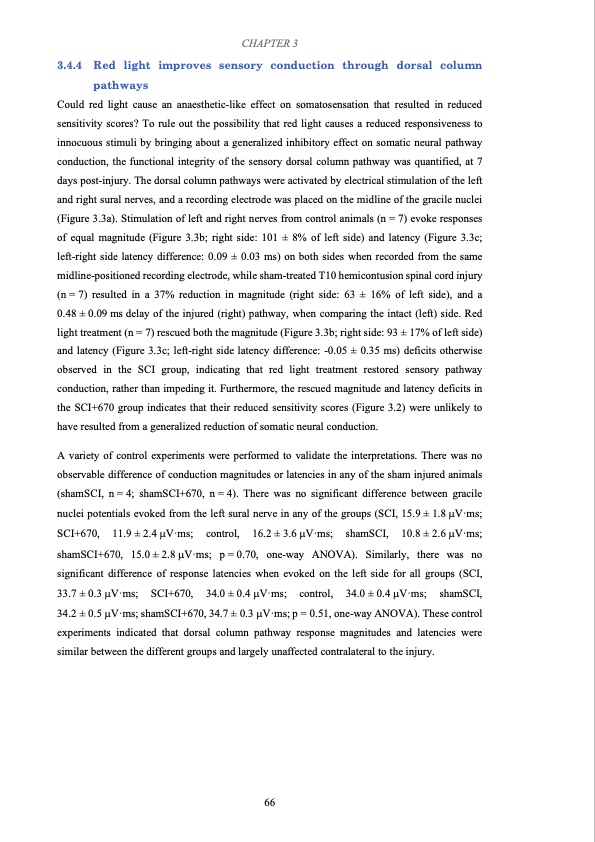
PDF Publication Title:
Text from PDF Page: 080
CHAPTER 3 3.4.4 Red light improves sensory conduction through dorsal column pathways Could red light cause an anaesthetic-like effect on somatosensation that resulted in reduced sensitivity scores? To rule out the possibility that red light causes a reduced responsiveness to innocuous stimuli by bringing about a generalized inhibitory effect on somatic neural pathway conduction, the functional integrity of the sensory dorsal column pathway was quantified, at 7 days post-injury. The dorsal column pathways were activated by electrical stimulation of the left and right sural nerves, and a recording electrode was placed on the midline of the gracile nuclei (Figure 3.3a). Stimulation of left and right nerves from control animals (n = 7) evoke responses of equal magnitude (Figure 3.3b; right side: 101 ± 8% of left side) and latency (Figure 3.3c; left-right side latency difference: 0.09 ± 0.03 ms) on both sides when recorded from the same midline-positioned recording electrode, while sham-treated T10 hemicontusion spinal cord injury (n = 7) resulted in a 37% reduction in magnitude (right side: 63 ± 16% of left side), and a 0.48 ± 0.09 ms delay of the injured (right) pathway, when comparing the intact (left) side. Red light treatment (n = 7) rescued both the magnitude (Figure 3.3b; right side: 93 ± 17% of left side) and latency (Figure 3.3c; left-right side latency difference: -0.05 ± 0.35 ms) deficits otherwise observed in the SCI group, indicating that red light treatment restored sensory pathway conduction, rather than impeding it. Furthermore, the rescued magnitude and latency deficits in the SCI+670 group indicates that their reduced sensitivity scores (Figure 3.2) were unlikely to have resulted from a generalized reduction of somatic neural conduction. A variety of control experiments were performed to validate the interpretations. There was no observable difference of conduction magnitudes or latencies in any of the sham injured animals (shamSCI, n = 4; shamSCI+670, n = 4). There was no significant difference between gracile nuclei potentials evoked from the left sural nerve in any of the groups (SCI, 15.9 ± 1.8 μV·ms; SCI+670, 11.9 ± 2.4 μV·ms; control, 16.2 ± 3.6 μV·ms; shamSCI, 10.8 ± 2.6 μV·ms; shamSCI+670, 15.0 ± 2.8 μV·ms; p = 0.70, one-way ANOVA). Similarly, there was no significant difference of response latencies when evoked on the left side for all groups (SCI, 33.7 ± 0.3 μV·ms; SCI+670, 34.0 ± 0.4 μV·ms; control, 34.0 ± 0.4 μV·ms; shamSCI, 34.2 ± 0.5 μV·ms; shamSCI+670, 34.7 ± 0.3 μV·ms; p = 0.51, one-way ANOVA). These control experiments indicated that dorsal column pathway response magnitudes and latencies were similar between the different groups and largely unaffected contralateral to the injury. 66PDF Image | Effects of Red Light Treatment on Spinal Cord Injury

PDF Search Title:
Effects of Red Light Treatment on Spinal Cord InjuryOriginal File Name Searched:
Thesis_Di Hu_final.pdfDIY PDF Search: Google It | Yahoo | Bing
Cruise Ship Reviews | Luxury Resort | Jet | Yacht | and Travel Tech More Info
Cruising Review Topics and Articles More Info
Software based on Filemaker for the travel industry More Info
The Burgenstock Resort: Reviews on CruisingReview website... More Info
Resort Reviews: World Class resorts... More Info
The Riffelalp Resort: Reviews on CruisingReview website... More Info
| CONTACT TEL: 608-238-6001 Email: greg@cruisingreview.com | RSS | AMP |